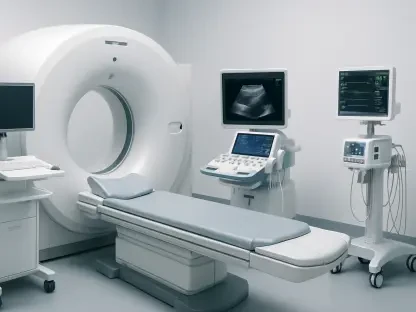In the intricate landscape of Australian healthcare, managing hospital waste stands as a formidable challenge that directly influences public health, environmental sustainability, and the safety of medical staff. Every day, facilities across the nation generate an immense volume of waste, ranging from hazardous materials like sharps and contaminated supplies to everyday refuse. Mishandling this waste can trigger severe repercussions, such as environmental contamination, heightened infection risks, and workplace injuries like needle-stick incidents. Addressing these issues requires more than just stricter rules; it demands a fundamental shift in approach. This article delves into a pioneering strategy that targets the behaviors of healthcare professionals, aiming to transform waste management practices from the ground up and ensure safer, more sustainable hospital environments.
Unpacking the Challenges of Hospital Waste
Identifying Systemic Shortcomings
The traditional frameworks for waste management in Australian hospitals often fall short of delivering consistent results, largely because they fail to account for the human factors at play. Rigid protocols and regulatory mandates, while essential, do not address the reasons behind non-compliance among staff working in fast-paced, high-stress settings. Common issues include uncertainty about how to classify different types of waste and inconsistent adherence to disposal guidelines. These gaps are not merely procedural oversights but are deeply rooted in the daily pressures and decision-making patterns of healthcare workers. Without a clear grasp of these behavioral drivers, efforts to improve waste handling remain superficial, unable to tackle the underlying causes of mismanagement. A closer examination reveals that many staff members are not intentionally negligent but rather lack the tools or clarity needed to navigate complex waste systems effectively.
Beyond procedural flaws, the broader impact of ineffective waste management looms large over hospital operations and public safety. Improper disposal can lead to significant environmental damage, such as groundwater pollution from hazardous materials, while also posing direct health threats through potential infection outbreaks. For staff, the risk of occupational injuries remains a constant concern, with mishandled sharps being a leading cause of harm. These systemic shortcomings highlight an urgent need for a reimagined approach that prioritizes understanding the motivations and barriers faced by healthcare workers. Only by addressing these human elements can hospitals hope to create a framework that not only meets regulatory standards but also fosters a safer, more responsible culture around waste disposal.
Global Implications and Local Context
Hospital waste mismanagement is not a challenge unique to Australia; it reflects a pressing global issue that affects healthcare systems worldwide. The environmental and health consequences of improper disposal—ranging from air pollution to the spread of infectious diseases—transcend borders, underscoring the need for solutions that can be adapted across different contexts. Australia’s experience offers a valuable case study, revealing both the specific hurdles faced by its hospitals and the potential for scalable strategies. The diversity of waste types and the complexity of disposal protocols mirror challenges seen in many countries, making the lessons learned here broadly applicable. By focusing on innovative methods, Australian healthcare facilities could set a precedent for others, demonstrating how localized efforts can contribute to a worldwide movement toward sustainability in medical waste handling.
Moreover, the stakes of improving waste management extend beyond immediate health and safety concerns to encompass long-term environmental stewardship. Hospitals are significant contributors to waste streams, and their practices directly influence community well-being and ecological balance. In the Australian context, where regulatory pressures and public expectations for sustainability are growing, the push for better waste practices aligns with national priorities. This intersection of local challenges and global relevance emphasizes the importance of developing frameworks that not only address current inefficiencies but also anticipate future demands. As healthcare systems grapple with increasing waste volumes, the insights gained from Australia’s efforts could inspire a ripple effect, encouraging international collaboration and the adoption of more effective waste management standards.
Pioneering Solutions for Sustainable Practices
Behavioral Insights as a Foundation
At the heart of transforming hospital waste management lies a critical realization: success depends on understanding and reshaping human behavior. Past initiatives often focused narrowly on enforcing rules or updating equipment, overlooking why healthcare staff struggle to comply with protocols. Recent studies highlight that issues like misclassification of waste or inconsistent disposal habits stem from a lack of clarity and accountability rather than willful disregard. By pinpointing these behavioral barriers, hospitals can move beyond temporary fixes to create lasting change. This approach involves analyzing the specific actions and decision-making processes of staff, allowing administrators to design interventions that address real-world challenges. Such a focus on behavior offers a refreshing perspective, shifting the narrative from blame to empowerment and equipping workers with the knowledge needed to handle waste responsibly.
Complementing this behavioral lens is the recognition that hospital environments are inherently complex, with unique pressures that influence staff actions. High workloads and time constraints often lead to shortcuts in waste handling, not out of negligence but as a coping mechanism in demanding situations. Addressing these realities requires more than just awareness; it necessitates a cultural shift within facilities to prioritize waste management as an integral part of patient care. When staff perceive waste disposal as a shared responsibility tied to broader safety goals, compliance becomes a natural outcome rather than a forced obligation. This deeper understanding of behavioral dynamics paves the way for targeted strategies that resonate with healthcare workers, fostering an environment where proper waste practices are both achievable and sustainable over time.
Targeted Training and Cultural Shifts
One of the most promising avenues for improving waste management is the implementation of tailored training programs rooted in behavioral psychology. These initiatives go beyond generic workshops, focusing instead on helping staff understand the rationale behind waste protocols and their direct impact on safety and sustainability. When healthcare workers see the connection between their actions and outcomes like reduced infection risks or environmental protection, they are far more likely to adhere to guidelines consistently. Such training must be continuous, integrated into daily routines rather than treated as a one-off event, to reinforce positive habits over time. By personalizing education to address specific challenges faced by different departments, hospitals can ensure that every staff member feels equipped and motivated to contribute to better waste practices.
Equally important is cultivating a hospital culture that values sustainability as a core principle alongside clinical excellence. When environmental stewardship is embedded into the ethos of a facility, it transforms waste management from a mundane task into a meaningful mission. Leadership plays a crucial role here, setting the tone by championing responsible practices and recognizing staff efforts in this area. This cultural shift fosters a sense of collective accountability, where everyone—from nurses to administrative personnel—feels invested in the outcome. Hospitals that successfully integrate sustainability into their identity often see higher engagement levels, as staff take pride in contributing to a larger purpose. Together, targeted training and cultural transformation create a powerful synergy, addressing both the practical and psychological dimensions of waste management.
Technology and Collaborative Innovation
Technology emerges as a vital ally in supporting behavioral change and enhancing waste management efficiency. Digital tools, such as systems for tracking waste and monitoring compliance, provide real-time feedback that helps staff adjust their practices on the fly. These platforms also enable administrators to identify patterns of non-compliance and address them promptly, ensuring issues don’t escalate into larger risks. For instance, automated alerts for incorrect waste segregation can serve as immediate reminders, reinforcing proper habits without relying solely on manual oversight. By integrating such technology into daily operations, hospitals can create a supportive framework that aligns with the behavioral insights driving modern waste strategies, ultimately reducing errors and improving overall safety standards.
Collaboration across hospital departments further amplifies the impact of technological and behavioral interventions. Each unit faces unique operational challenges, and fostering dialogue among teams ensures that solutions are customized to specific needs rather than imposed as generic mandates. Encouraging staff to share ideas and take ownership of waste initiatives builds a sense of empowerment, making compliance a collective goal rather than a top-down directive. Team-driven projects, such as pilot programs for new disposal methods, can uncover innovative approaches that might otherwise be overlooked. This collaborative spirit not only addresses practical hurdles but also strengthens the hospital community, aligning everyone around the shared objective of safer, more sustainable waste management practices.
Economic and Safety Advantages
Improving waste management through behavioral and technological strategies yields significant economic benefits for hospitals. By leveraging data from behavior identification methods, administrators can streamline waste handling processes, reducing unnecessary expenditures on inefficient disposal or emergency cleanups. For example, minimizing errors in waste segregation can lower the costs associated with managing hazardous materials, while optimized protocols can decrease the volume of waste sent to expensive treatment facilities. These savings allow hospitals to redirect resources toward patient care and infrastructure improvements, demonstrating that sustainable practices are not just ethically sound but also financially prudent. The economic argument adds a compelling layer to the case for revamping waste systems, highlighting tangible returns on investment.
On the safety front, the advantages of refined waste practices are equally profound, protecting both staff and patients from preventable harm. Reducing incidents like needle-stick injuries through better handling protocols directly enhances workplace safety, while proper disposal minimizes the risk of infections spreading within or beyond hospital walls. These safety gains are measurable, with data-driven approaches allowing facilities to track incident rates and adjust strategies accordingly. The dual impact of cost savings and risk reduction underscores the urgency of adopting innovative waste management solutions. As Australian hospitals navigate growing pressures to balance budgets and safety mandates, these benefits offer a clear path forward, proving that small changes in behavior and systems can yield outsized results for the entire healthcare ecosystem.
Reflecting on Progress and Future Steps
Building on Past Achievements
Looking back, the strides made in addressing hospital waste management through behavioral approaches marked a turning point for Australian healthcare. Efforts to understand staff actions and implement targeted training reshaped how facilities tackled disposal challenges, moving away from purely regulatory fixes to human-centered solutions. The integration of digital tools provided a backbone for monitoring progress, while collaborative initiatives across departments fostered a unified commitment to sustainability. These steps reduced risks like contamination and occupational injuries, reflecting a growing recognition of waste management as a critical component of public health. Hospitals that embraced these changes saw not only safer environments but also measurable cost efficiencies, proving the value of innovative thinking in overcoming longstanding hurdles.
Charting the Path Ahead
As the journey to perfect hospital waste management continues, the focus must shift to scaling these proven strategies across diverse healthcare settings. Administrators should prioritize expanding behavioral training programs, ensuring they reach every level of staff with customized content that addresses evolving challenges. Investment in advanced technologies for waste tracking and real-time feedback will be crucial to sustain momentum, offering scalable tools that adapt to different hospital sizes and needs. Furthermore, fostering international dialogue to share Australia’s insights could inspire global improvements, positioning the nation as a leader in sustainable healthcare practices. By building on past successes with a forward-looking mindset, the healthcare sector can tackle future demands, ensuring that waste management evolves into a seamless, integral part of delivering safe and responsible medical care.









